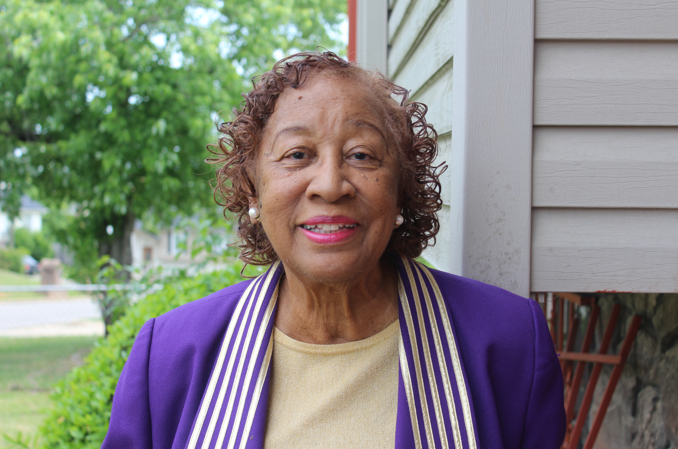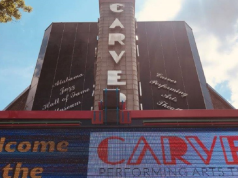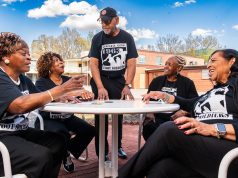
By Ariel Worthy
The Birmingham Times

Mable B. Anderson grew up in the frequently flooded neighborhood of Moro Park in Ensley, and she remembers when it would rain and the water would swell as high as three feet in the house where she was raised.
“One time, daddy had to cut a hole in the ceiling to get our family on the roof,” Anderson recalled. “When it would rain badly, everyone knew to get out early. Eventually, my dad had the house raised. Water wouldn’t get in the house, but you still had to worry about cars and other houses. That happened throughout my growing up years.”
Anderson is the founder of the Village Creek Human and Environmental Justice Society Inc. Commonly called the Village Creek Society (VCS), this nonprofit organization, founded in 1980 and incorporated in 1999, addresses the extensive flooding of the Village Creek watershed. The group’s mission is to improve the entire length the creek to benefit the 300,000-plus residences, businesses, schools, and churches in the area.
Village Creek runs 44 miles from Roebuck Springs and the East Lake area through North Birmingham and down to the Black Warrior River. Known as the largest urban watershed in Alabama, the creek used to flood continually and cause significant destruction for residents along its path.
Raising Awareness
Families—mostly black—moved into the Village Creek watershed in the 1920s and bought homes in the Moro Park Ensley and South Pratt areas at or near the banks of the creek. They were unaware of the flooding, which occurred frequently and would inundate their homes with as much as four to eight feet of water.
Anderson left Birmingham in 1960, and when she returned in 1977 she saw that her community was still flooding. She knew something had to be done, and in 1980 she gathered a group of people to raise awareness about the flooding.
“At the time, no one in the city, county, or federal really paid attention to it,” said Anderson, who was born in 1930 and has devoted her life to improving the environment and her community.
She has served as chairperson of the Moro Park Ensley/South Pratt Flood Coalition, the Village Creek Flood Plain Relocation Committee, and the Village Creek Environmental Protection Agency (EPA).
Focus on Education
Anderson, who also served as vice president of the Ensley Neighborhood Association, has always been focused—on education, in particular.
She graduated from A.H. Parker High School at 16 years old. And between 1950 and 1985, she amassed several academic achievements.
Anderson has three degrees: a doctorate in developmental psychology, a master’s in supervision, and a bachelor’s in sociology. She has received four certificates from various universities throughout the country. And during her career, she has taught at several prestigious institutions, including the University of Alabama, Tuskegee University, Miles University, Grambling State University, the University of Georgia, Michigan State University, Pennsylvania State University, and Fordham University.
After graduating from Parker, Anderson wanted to attend Howard University, “but I already had two sisters at Hampton [University] and one at Tuskegee,” she recalled. Anderson said her parents asked if she didn’t mind going to Tuskegee until her sisters finished at Hampton, “then I could go to Howard.”
Anderson agreed, and she didn’t wait for her sisters. She finished at Tuskegee in three years, receiving a degree in education.
“I took as many as 27 hours a semester, and I finished college when I was 19,” she said. “I liked it, and I was into everything. I wasn’t just a bookworm. I attended conferences, joined clubs. I am thankful for everything Tuskegee provided for me.”
After college, Anderson was hired for a high school teaching position.
“I didn’t like it,” she said. “I wore high-heeled shoes and dark clothes to look old. I was trying to get my respect because it was hard for students to respect me because I was so young.”
Wanting to do more than teach, Anderson returned to college to get her master’s degree. She enrolled at Michigan State University.
“I think I was the only female [black] person [there] at the time,” she said. “There was a man from Jamaica, and we were the only [blacks].”
Anderson had to make higher grades because of her skin color: “I couldn’t make below a B, or they would kick me out.”
Miles College
While at Michigan State, the Jamaican student, Cleveland Allen, proposed to her.
“I told him, ‘I want to get my doctorate, too. If I marry you now, I can’t get mine,’ Anderson said. “[Allen] had to go back to Jamaica to work. I told him, ‘If you come back to the United States, I’ll see what we can work out.’ I thought it was nice of him to ask.”
After receiving a master’s degree in supervision and sociology, Anderson decided she wanted to get back into teaching, so she went to Grambling University and became a teacher trainer in education.
“They tried to treat me like a little girl even [though] I had a master’s degree and was really good,” she said. “I enjoyed my time there, but I moved back home and taught at Miles College. While I was at Grambling, though, this guy fell in love with me, and I decided to marry him. My family really, truly loved him more than I did. I was engaged to him for some years and kept working at Miles.”
Mable Bell married Furman Anderson in 1958, but unlike most women during that time she said she continued to further her education. The two were married until Furman died in 1999.
Breaking Barriers
By 1960, Anderson decided to attend Penn State, where she became the first African-American to receive a doctorate in developmental psychology.
“It was tough. They didn’t play around,” she said, recalling one particularly tough class and incident.
“I made all A’s on my tests, but received a B for my final grade,” Anderson said. “I thought it was strange, so I asked my professor how he added up the scores. After all, I had been a teacher, so I knew something wasn’t right. He said, ‘Well, somebody had to make a B. You’re colored, so you had to be the one.’ I could have hurt him. I didn’t want people to see that he had embarrassed me, though, because it was in front of the class.”
Anderson recalled having to solve problems by hand because computers and calculators were not around at the time. When Penn State finally did get a computer, the woman who oversaw her dissertation didn’t even know what to do with it, so Anderson taught herself how to use the computer.
“I spent many nights up all night doing research, and I had to go to class the next morning looking good and ready to respond,” Anderson said. “If I wanted to get it, I had to be tough. That’s just how it is getting a doctorate.”
Back Home
After receiving her doctorate, Anderson continued to teach at several colleges. She also established graduate programs in early childhood development at both Tennessee State University and Western Kentucky University, where she was ranked as full professor.
After returning to Birmingham in 1977, Anderson saw that families were still dealing with the flooding caused by Village Creek—and she decided to do something about it. She established the VCS, which initially conducted rescue efforts by getting get residents out of the area through canoes and boats.
“Folks weren’t paying attention to us,” Anderson said. “If they weren’t going to do it, I knew we had to do something about it.”




